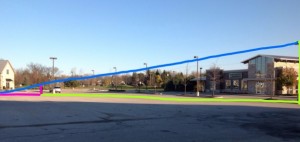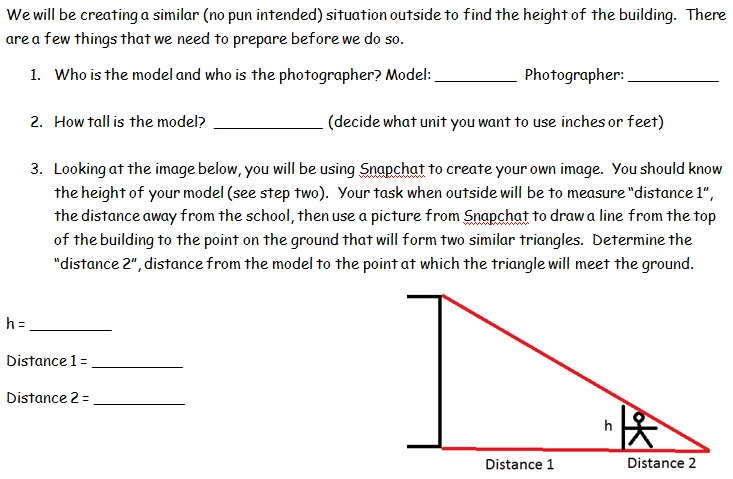Did you see their face swap? Did you post it to your story?
Snapchat seems to be the only thing students (and a growing number of adults) worry about most of the day. Kids are constantly finding creative ways to make funny pictures and send them to friends. Adults are constantly posting how great their vacation or night on the town is going. Being the tech-curious person I am, I decided to develop a different way to use it in a math classroom. Check it out.
Lesson: Applying Similar Triangles
Course: Honors Geometry with mostly freshman and a handful of sophomores
Lesson Objective: Determine the height of the school building using only a ruler and Snapchat.
Standard: ACT CCRS (G 603); CCSS (G.SRT.B.5)
Previous Knowledge: By the time I taught this lesson, we had discussed congruent figures and had discussed that corresponding sides of similar triangles have the same scale factor. We had also discussed the congruence and similarity theorems. Students had worked out problems and we more or less comfortable with problems like those below.
Lesson: Ideally, I wanted to take the students outside to measure the height of the building, but it did not work out for whatever reason. I ended up giving the students the assignment as an extra credit opportunity and asked them to find the height of their house or some other object that was at least two stories tall. I handed out the following, then did my best to explain to students what I wanted them to do. I also created this template for students to organize their thoughts and upload a picture of them in action.
Results: Here are a few examples of student work.
Sample 1:
 I really liked this student’s work. They seemed to understand the idea well. I discussed with them to remember that he started a little below the ground (standing in the street). Also, note this assignment may encourage to stand in the road for a pose. Probably not the best…
I really liked this student’s work. They seemed to understand the idea well. I discussed with them to remember that he started a little below the ground (standing in the street). Also, note this assignment may encourage to stand in the road for a pose. Probably not the best…
Student’s Reflection: “The only thing that can be improved is maybe try it in class too.”
Sample 2:
 This student may have understood the general premise, but missed the importance of precision (at least in the drawing).
This student may have understood the general premise, but missed the importance of precision (at least in the drawing).
Student’s Reflection: “We probably did it wrong. I thought it was kinda a cool project of how you can find the height of an object outside just by using snapchat and math. What can be improved for next time is showing an example of this project.”
Sample 3:
 We had covered many of those “if John has a 6ft shadow and the tree has a 15ft shadow…” problems and this student – along with others – believed they needed to use shadows to solve the problem. Unlucky for them, they chose to do the project at sun-down. Whoops.
We had covered many of those “if John has a 6ft shadow and the tree has a 15ft shadow…” problems and this student – along with others – believed they needed to use shadows to solve the problem. Unlucky for them, they chose to do the project at sun-down. Whoops.
Student Reflection: “It was nice to apply the concepts learned in class to real life situations. The most difficult part was trying to find where the shadow actually started and ended. Also, it was a challenge to get the whole picture in one entire frame. Next time, it would be better if we could do this kind of activity in school so that we can verify if we are doing it correctly.”
My Reflections
I really enjoyed the work that I got back from students. I am curious if this was only a successful application because it was an extra credit assignment for honors students. Most likely, it would need to be modeled or carefully explained if it was expected for all students of varying abilities to find success with it.
A question I have is whether the lesson could have been more or less effective with less specific direction. I am a big fan of 3 Act lessons which leads students to ask the questions and determine what information is necessary to solve a problem. Rather than giving them problems similar to the situation beforehand, could we somehow introduce the situation and have them draw the conclusions by themselves? Even if we covered similar triangles deeply before the activity, maybe we could let students struggle with how the task could be completed with just Snapchat and a ruler.
Please let me know if you read this and have any suggestions! I’d love to build it into an even more meaningful lesson for others to use.
p.s. What if snapchat somehow came up with an educational aspect of its application? That’d be the bees knees.

